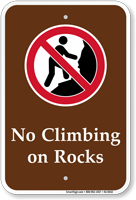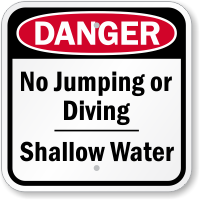How do I warn about natural hazards on campgrounds?
Here’s another question we’ve gotten. Just what are the best practices to warn campers of potential hazards at your campground? According to the 2017 North American Camping Report, camping is a growing industry, with about 61% of households in the United States being active campers.

With more people going camping, it also raises the possibility of injury or property damage, as well as the possibility of lawsuits. Lawsuits are expensive, after all, and personal injury lawyers love to brag about their prowess in getting settlements after tragedies. With this in mind, we offer some simple guidelines for campground owners to help make your premises safer. (If you have specific legal questions, as always, contact an attorney or a safety professional.)
The first issue is to consider what hazards you know about on your camping property. The most common rule of premises liability law is that you’re required to warn occupants of hazards that you’re aware of, for their own safety. Let’s say, for example, that you have a pond on lands that belong to your campground. Because there’s water, you should consider what the drowning hazard is, as well as potential swimming and diving-related injuries. Drowning is the 5th most common cause of death by unintentional injury in America, and a leading cause of death of children under 14. Similarly, diving is responsible for over three-quarters of recreation-related spinal cord lesions. In cases like these, it would be a good idea to post no swimming or no diving signs, as well as to take into account any potentially dangerous wildlife that your customers might not know about.
Second, you should take a full inventory of who’s likely to use your facilities, and to take into account any misuse of your facilities that may occur. This means attempting to anticipate things like children who may not be old enough to understand warnings, or teenagers who engage in rough horseplay around your campground. (This doesn’t, however, include fires, floods, thunderstorms and other types of natural disasters, which are considered to be unpredictable.) For those kinds of possibilities, it’s best to mark individual hazards as well as to provide general warnings. Going back to the previous example: let’s say that you have a campground with a pond on the property, and that there are dangerous alligators in the pond. Even if you post “no swimming” and “no diving” signs, it would be reasonable to assume that people would ignore those rules, especially if you expect minors to be at your campground. Thus, the next logical step would be to post alligator signs to make sure that campers are aware of the hazards.
Third, if you have those hazards, consider whether your insurance covers the hazards you know about, determine what your level of monetary exposure is, and speak with them about a contingency plan in the event of an accident. Personal injury litigation is expensive and runs a risk of harming your campground’s reputation, and if you don’t have a plan to respond to a potential lawsuit, you may be caught off guard.
Finally, as always, if you need campground signs, consider buying your campground signage from SmartSign, where we have the best products at the lowest prices on the Internet, guaranteed.



